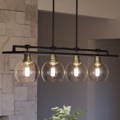The Utilitarian Design Style
Utilitarian design style in residential interior design is characterized by its emphasis on function, efficiency, and simplicity. Rooted in the industrial era's ethos, this design approach prioritizes the use and purpose of every element within a space, ensuring that each component serves a practical role. In a utilitarian-designed home, there's a distinct lack of superfluous decor or ornamentation. The aesthetics are raw, often highlighting the foundational materials used in the space, such as exposed brick, raw wood, and metal fixtures. This honest exposure of materials pays homage to the construction and craftsman elements of the design.
Space optimization is paramount in utilitarian interiors. Multi-purpose furniture, such as modular sofas, expandable dining tables, and functional storage solutions, exemplify the design's practical nature. Color palettes lean towards neutral tones, working in tandem with the natural materials to create a cohesive and harmonious environment.

Utilitarian Style Architecture
Originating from the industrial age, this style reflects a pragmatic approach, often showcasing structures in their rawest forms, highlighting essential structural elements like beams, columns, and raw materials. There is minimal ornamentation, with a strong emphasis on linear and geometric forms. The structures display very materials and techniques used in their construction, without the veil of decorative embellishments.
Utilitarian architecture prioritizes function over aesthetics.
It prominently showcases raw materials and structural elements.
Buildings often have a minimalistic and geometric appearance.
There is a noticeable absence of ornate detailing or excessive decorations.
The design often reflects an industrial influence, emphasizing simplicity and efficiency.

Utilitarian Style Materials
Materials that are functional, durable, and in their natural state are favored. Exposed steel is frequently used for its sturdiness and industrial feel. Concrete, both in floors and walls, provides a minimalist and robust backdrop. Reclaimed or unfinished wood adds warmth and texture, contrasting the colder metals and concrete. Glass ensures optimal natural light, reinforcing the design's focus on efficiency. The textiles used are understated and durable, avoiding unnecessary frills or decorativeness.
Steel in utilitarian designs offers a robust and industrial appeal.
Concrete surfaces, whether floors or walls, exude a raw, minimalist charm.
Unfinished or reclaimed wood introduces a touch of organic warmth.
Large expanses of glass ensure spaces are well-lit and efficient.
Durable textiles are chosen for their longevity and simplicity, devoid of excessive ornamentation

Utilitarian Style Colors and Finishes
The style employs colors and finishes that exude simplicity and authenticity. As such, neutral tones, including shades of grey, beige, black, and white dominate, reflecting the raw materials used. These muted colors allow the functionality of the design to shine. Finishes tend to be more matte than glossy, with an emphasis on textures that are tactile and genuine. As such, metals might be left untreated or oxidized, and woods kept raw or lightly stained.
Neutral tones, especially greys and beiges, are predominant in utilitarian design.
Black and white are used for stark contrast and clarity in the space.
Matte finishes are preferred over high gloss to maintain authenticity.
Metals may be untreated, showcasing their natural patina or oxidation.
Wood surfaces lean towards raw or lightly stained finishes, emphasizing their natural grain.

Utilitarian Style Furniture and Decor
Furnishings are streamlined, devoid of unnecessary embellishments, and often have a robust, industrial feel. The materials used for furniture include steel, wood, and concrete. Modular pieces, which can be adapted or reconfigured based on need, are popular. Decor is minimal and purposeful. When accessories are used, they often have a dual function, serving both a practical purpose and adding to the aesthetics. Artworks or decorative items present carry a story or a sense of history.
Furniture in utilitarian designs is streamlined and functional, lacking superfluous details.
Industrial materials like steel and wood dominate furniture pieces.
Modular furniture, adaptable to various needs, is a staple in this design style.
Decorative items are minimal, chosen for both their aesthetic and practical value.
Any artworks or ornaments often possess a narrative or historical significance.

Utilitarian Style Lighting
Exposed bulbs, pendant lights with simple metal shades, and adjustable task lamps are common choices. The fixtures showcase raw materials like metal, glass, and occasionally, wood. They provide ample light for tasks while also distributing ambient lighting harmoniously. Track lighting and recessed fixtures offer flexibility, allowing one to direct light as needed. This results in clean, direct setups that evoke a sense of vintage industrialism.
Exposed bulbs offer a raw, industrial feel typical of utilitarian design.
Metal-shaded pendant lights provide focused illumination, perfect for task areas.
Adjustable task lamps enhance functionality, allowing precise control over lighting.
Track lighting systems are favored for their flexibility in directing light.
Recessed fixtures ensure a clutter-free ceiling, aligning with the design's minimalist ethos.